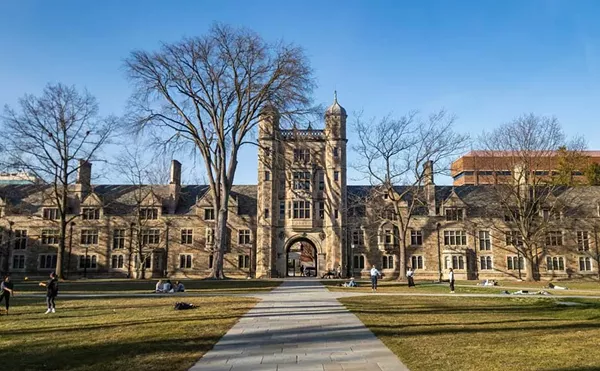The yellow-and-blue rail cars of the new Ann Arbor to Detroit commuter line slip into the transfer platform at the New Center station. On the other side are the sleek cars of the Woodward Avenue light rail line, with stops every mile or so, taking thousands of passengers to jobs, lofts and entertainment in downtown Detroit.
Last month, without fanfare, the Southeast Michigan Council of Governments quietly posted an analysis of this regional rapid transit option, and nine other ways to move people back and forth between Detroit and Ann Arbor, with stops in the city and at Metro Airport, Ypsilanti, Dearborn and several more suburbs.
The analysis, which clearly indicates that reviving rail transit in Detroit and its suburbs is technically feasible and practical, comes as popular support in southeast Michigan for public transit appears to be increasing. Last week, citizens, by a 70 percent to 30 percent margin, voted to pay for the SMART suburban bus system in Oakland, Macomb and Wayne counties with their property taxes. The highest support — 76 percent — came from Oakland County, where 64,718 voters said yes to the millage, three times more than the 20,465 people who opposed it.
"Imagine how great the results would be if we had a chance to vote to invest in a regional rapid transit system that people were really excited about," said Megan Owen, the executive director of Transportation Riders United, a Detroit-based advocacy group. "People already support it. How long will we have to wait before our elected officials catch up?"
The answer to that question, perhaps, is not much longer. Two years ago, SEMCOG launched a research project to determine whether building a rapid transit line along the 50-mile Detroit-to-Ann Arbor corridor is feasible technically and financially. The proposed line, which last year received $100 million congressional commitment for engineering, design and construction, could be Detroit's rapid transit starter line, the one that shows that commuters, residents and visitors will use something other than their private vehicles to get around. Such starter lines have been essential to making the case for building the modern regional systems that are strengthening the economic competitiveness of Denver, St. Louis, Dallas, San Diego, Portland and more than a dozen other metropolitan regions.
SEMCOG's newest assessment seems to clearly answer the technical side of the question. The regional planning and research agency's contractor, the California-based Parsons Corporation, looked at separating or combining three basic technologies to move passengers:
• 60-passenger rapid buses traveling in new dedicated lanes on Business Route 94, Michigan Avenue and a high-occupancy-vehicle (HOV) lane on I-94.
• 62-passenger light rail cars traveling on newly built dual tracks along Michigan Avenue to Ypsilanti, and in the middle of Business Route 94 from Ypsilanti to Ann Arbor.
• Diesel-propelled commuter rail cars along existing Norfolk Southern tracks from New Center to Chelsea, with three to eight other stations. The commuter rail options also come with light rail connections to downtown Detroit along Woodward Avenue or Michigan Avenue. One of the commuter rail options under study would start at the Joe Louis Arena and end at Metro Airport. Passengers going farther would have to transfer to a rapid bus line for the ride to Ann Arbor.
Regardless of the technology that SEMCOG may eventually choose — that decision has been delayed due to difficulties in predicting how popular the lines could be — all three technologies would operate on similar schedules.
Parsons envisions operating from before dawn to midnight Monday through Saturday, and from 8 a.m. to 8 p.m. on Sunday. Trains or buses would arrive in stations every 20 minutes during rush hour, every 30 minutes the rest of the day, and every 60 minutes on weekends. The trip between the two cities would take an hour. Fares would be levied by zone, with tickets from Detroit to Ann Arbor costing a maximum of $6 each way; tickets from either city to the airport would be $3, and it would cost just $1.50 to ride between stations in any single zone.
The new assessment, though, offers no new details about the potential cost of building and operating any of the alternatives. That report, which also will include SEMCOG's recommendation for what to build, has been delayed because analysts are having trouble predicting how many people might actually use the line, according to Carmine Palombo, SEMCOG's director of transportation programs.
In an Aug. 7 memo, Palombo said that because there is no similar public transit between the two cities, forecasters have scant data to project future ridership, which is essential in convincing the Federal Transit Administration to help pay for the project. Parsons is developing a mathematical model to predict ridership, but the work won't be finished until late September, said Palombo.
"These numbers are very important because they are used in calculations of projected revenue and operations costs," Palombo added. "They also are inputs into the FTA model that prioritizes this project against the other proposed projects across the country."
Even without the cost and ridership numbers, SEMCOG's latest report on the Detroit to Ann Arbor line nevertheless stirred considerable interest in the community of advocates who view regional rapid transit as a missing piece of civic equipment in southeast Michigan.
"My hope is that a rapid transit line between Ann Arbor and Detroit is on an inevitable path at this point," said Conan Smith, the 34-year-old executive director of the Michigan Suburbs Alliance, which represents 22 cities and 930,000 residents in Wayne, Oakland, Macomb, Washtenaw and Monroe counties. "My feeling is that urban residents will gravitate to it more quickly, especially commuters. But you're going to see a ton of people use it, people driving into Detroit and Ann Arbor, people going to the airport."
Smith, who also is an elected county commissioner in Washtenaw and was recently appointed to SEMCOG's executive committee, believes the best technologies for the line are commuter rail or light rail, or a combination. One of the alternatives he supports uses commuter rail cars that follow the existing Norfolk Southern line from New Center to Chelsea, west of Ann Arbor, with stops at west Detroit, the Henry Ford, a connector to Metro Airport, Wayne, Depot Town, Ann Arbor and Dexter. A separate light rail line would be built along Michigan Avenue, carrying passengers from Times Square in downtown Detroit to the Fairlane Town Center at Evergreen Road, with stops at MGM Grand, Corktown, Grand Boulevard, west Detroit, the I-94 Park and Ride, Dearborn and Ford's headquarters. Passengers would transfer to either line by simply walking across a platform at Fairlane Town Center.
Smith is convinced that a rail option is the right choice. If SEMCOG chooses a rapid bus technology, he says it won't galvanize voter or governmental support. "If they just say rapid bus, you'll lose a lot of support from Washtenaw," said Mr. Smith. "Sitting in traffic on I-94 is something we're really good at. I don't think we need to sit in a bus to do that."
Keith Schneider, a journalist and editor at the Michigan Land Use Institute in Beulah, is a regular contributor to Metro Times. See annarbordetroitrapidtransitstudy.com for the SEMCOG report.





